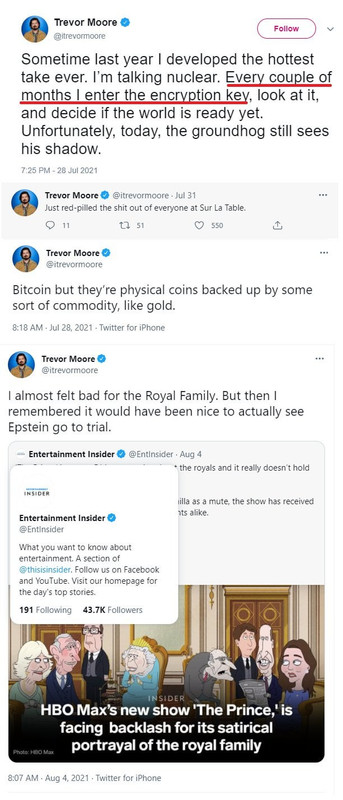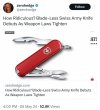Congrats! That's awesome!!!HAY!
A big congratulations to the CPK cutting team! Some historic firsts today. Ben won Nationals, again, making this his third championship title in a row which is unprecedented. And Sue, his wife, won women's nationals for the first time. Making this the first man-wife team to ever win championship titles.
(And congratulations to me for having such a remarkable team of Bladesports competitors!)
View attachment 2564889
You are using an out of date browser. It may not display this or other websites correctly.
You should upgrade or use an alternative browser.
You should upgrade or use an alternative browser.
Random Thought Thread
- Thread starter Nathan the Machinist
- Start date
carnifex knifeworks
Gold Member
- Joined
- Dec 11, 2022
- Messages
- 1,748
Congrats CPK team! Not sure if I already said that or not. Lack of sleep does funny stuff to your brain.
Since Ben is holding 3 titles and it's a first I would think blade sports magazines would be itching to get an interview. Where else might the historic wins be documented?
Since Ben is holding 3 titles and it's a first I would think blade sports magazines would be itching to get an interview. Where else might the historic wins be documented?
SwarthyGnome
Gold Member
- Joined
- Nov 1, 2018
- Messages
- 1,538
HAY!
A big congratulations to the CPK cutting team! Some historic firsts today. Ben won Nationals, again, making this his third championship title in a row which is unprecedented. And Sue, his wife, won women's nationals for the first time. Making this the first man-wife team to ever win championship titles.
(And congratulations to me for having such a remarkable team of Bladesports competitors!)
View attachment 2564889

tinfoil hat timmy
Gold Member
- Joined
- Aug 21, 2014
- Messages
- 18,674
I miss Trevor
tinfoil hat timmy
Gold Member
- Joined
- Aug 21, 2014
- Messages
- 18,674
tinfoil hat timmy
Gold Member
- Joined
- Aug 21, 2014
- Messages
- 18,674
also congrats
carnifex knifeworks
Gold Member
- Joined
- Dec 11, 2022
- Messages
- 1,748
Happy Monday! Hope everyone's week goes well!
tinfoil hat timmy
Gold Member
- Joined
- Aug 21, 2014
- Messages
- 18,674
it cant possibly be WORSE tomorrow so theres that.Happy Monday! Hope everyone's week goes well!
BenR.T.
Tanto grinder & High performance blade peddler
Moderator
Knifemaker / Craftsman / Service Provider
- Joined
- Apr 18, 2011
- Messages
- 4,919
Thanks for the info Nathan! And since I was mentioned in the original post I'll chime in briefly. My Protocol was based on Nathans original info posted publicly here in his massive research endeavor to develop the very best protocol possible for 3V.The Delta protocol is one of the low temp tweaks. I was doing development work on the low temperature tweaks (a heat treat that does not use the secondary hardening hump and addresses retained austinite through rapid quench to cryogenic temperatures instead) for years. Keffeler was also. This is how we got to know each other.
There was a batch of 3V that did not have normal heat treat response. This was back when I was making the original Shiv many years ago. I had done experiments with prequenching D2 with excellent results and I applied what I knew from D2 to 3V and it addressed the issue. But not for the reason that I thought. (prequenching is performing a heat treat on a complex steel at a lower aust temp and then performing another heat treat at a higher aust temp. This has the effect of reducing grain size but it is risky because it is possible to dissolve the carbides pinning the grain boundaries and actually have explosive grain growth if done improperly. This is specific to complex steels whose grain size is otherwise baked in) It turns out that an anneal carried out over a 24-hour period was all that batch really needed. I suspect it was highly spheroidized which affected the availability of carbon to go into solution and had an effect on the final heat treat. Interestingly, this problem could not be found with a hardness test, it was only apparent in an edge stability test which is where I noticed it, Dan noticed it, and Guy noticed it. Because we were all testing our work and we saw the problem. The problem was probably not even noticeable to folks using a high temperature protocol (The standard for tool and die) not because it wasn't present, but the standard heat treat was already chippy mushy and would have appeared relatively normal. The three of us went together and did the work to do an exhaustive development cycle with the heat treat of CPM 3V. I spent most of one winter solely on this process. I'm not a metallurgist. Other than a couple materials and processes classes I took at NC State back in the '90s, most of what I know about metallurgy is from the internet and books. But I had a significant professional background in product and process optimization at this point because I had just come off of a 10 year stint at TecRep Engineering as the product design manager. We had a process of creating a matrix of variables and (more or less blindly) modifying variables and measuring both the outcome and the interaction on each other. The best example of this was our foam generator development work we did for a chemical company in Greensboro. But that's another story. But the process for developing the Delta protocol was as simple as introducing and modifying variables, the timing of steps, adding steps, and effectively evaluating the outcome which meant standardizing on a sharpening angle, test media, and eliminating variables such as overheating the edge etc in an effort to maximize the signal to noise ratio. It is a very stringent process based on observation and comparative testing kind of like the Mohs hardness scale where this mineral scratches that mineral. You have test standards and you run them all through the same media and then you look at the edge under bright light and magnification and objectively observe which edge has accumulated the most damage - edge loss. I had run D2 through this process before. The most significant finding that I can share with you is that abrasive wear resistance is largely built in, toughness in 3v is largely baked in unless you screw it up (which is entirely possible which is actually why I started making videos in the first place, to demonstrate that I had not screwed it up) and that edges don't really go dull through just abrasive wear but through edge loss-damage that can be summarized as edge stability. Which can be broken up into fine edge stability and gross edge stability. Conventional 3V has a chippy mushy edge. When using the secondary hardening hump this is due to a soft weak carbon lean martensite attempting to support a growing carbide volume fraction. This is why I don't like edge retention testing that is based on where resistance such as lightly sawing at abrasive cardstock to try to determine which steel and heat treat have the best edge retention. That isn't edge retention for most people. But I digress again.
I did the majority of the work and claim credit for the development of this heat treat, but the three of us went in together and the three of us have access to that protocol. Peters was not able to duplicate it at first and had to make some changes to their process equipment but after a while they got there and they are frequently able to apply the process better than I can now, depending on the knife geometry. Probably because my heat treat set up is worth about $5,000 and theirs is about half a million dollars.
There have been improvements to both the steel manufacturing process and the heat treat process since we originally released the new Delta protocol, if anybody has noticed, the work today is the best it has ever been.
Anyways. Very long story short. The early low temperature tweaks were being openly discussed on this very forum and also hype free blades and some other places and those original low temperature tweaks are freely available at Peter's heat treat, and their heat treat is particularly well suited for it after their development work with us with this particular steel. They're good at it.
So, when they are saying they are using a variation of the delta protocol, this is essentially true. They're using one of the low temperature tweaks that we used to use that is freely available to anyone who gets their work heat treated at Peters. It is a very good heat treat. The Delta protocol is measurably better and (also very important) very consistent from heat lot to heat lot. But the Delta protocol is not enormously better than the available low temp tweak at Peters. It developed from it, they are related, and you would have to have two identical samples in hand side by side to see the difference in use. I have no problem with their statement.
Being friends with Keffeler also, talking with him I was able to develop and slightly tweak over time into my current process. I don't call it Delta 3V, because that is Nathans thing. But I couldn't do what I do with 3V without Nathan or Dan's input and research.
I have recently started labeling my knives with the "3V+" mark, simply to denote its differences from a factory higher temperature protocol.
When Ed Braun reached out for RMJ about wanting to improve their 3V, I shared my process with him because he and Ryan are my friends and stand up guys. I told him the same thing as above, so I am sure that is why he referenced the Delta protocol. Because Nathan (and Dan) should certainly be credited with totally changing the industry and certainly my business with all of their hard work and time spent.
Last edited:
clinton1
Gold Member
- Joined
- Jan 17, 2022
- Messages
- 1,028
1AbominAble1
Gold Member
- Joined
- Jul 26, 2010
- Messages
- 2,338
How absolutely ridiculous is that sh#%
It reminds me of a vid that popped up in the feed on YouTube this weekend. It was about a British couple that was visiting Texas and while there went to a gun range/store. They fired a .22lr pistol and an AR, then commented about how crazy it was that the store that sells firearms as a business just had so many of them hanging on the walls.
After remarking about how cool it was to fire the guns they talked about how they can’t do any of this at home and how crazy it is here, like we’re the crazy ones!
Crazy is jobbing out your safety to an unarmed Police force that’ll show up 30 minutes after the home invasion is over, so that they can remove your corpse, after you’ve been shot, or stabbed, or beaten to a pulp with an axe handle.
As they ban pointed kitchen knives and move to melee weapons I wonder if golfers will eventually need a permit to buy their clubs. Maybe they’ll be required to be a member of a country club and be forced to store them there under lock and key.
How sickening. The people that probably shouldn’t be running a Government, and that probably shouldn’t be trusted with the power of a thermonuclear weapon, think that you can’t be trusted with an inch and a half blade that’d mostly be used to clean under your fingernails.
trevitrace
Gold Member
- Joined
- Jul 21, 2013
- Messages
- 20,855
Looks pretty handy to take on a plane.
tinfoil hat timmy
Gold Member
- Joined
- Aug 21, 2014
- Messages
- 18,674
I think I'm still afraid. it could poke someones eye out with either end.
do you have one with just the toothpick and tweezers?
Last edited:
Fonedork
Gold Member
- Joined
- Jul 7, 2011
- Messages
- 5,067
clinton1
Gold Member
- Joined
- Jan 17, 2022
- Messages
- 1,028
Damn..... "Safely disposed and taken off the streets"...
Not all hero's wear capes I guess.....
- Joined
- Oct 2, 1998
- Messages
- 39,920
WTF? Seriously?
I was last in London in 2002 or so on a case...and they were a bit crazy, even back then.
My buddies from Scotland Yard had run me and my partner over to the airport and accompanied us to the gate where we were presented to the airline staff prior to flight. They knew we were feds, and the detectives from the Met had identified themselves.
There were a number of folks who would have fit the "profile" post 9/11, but the only ones that had to take off their shoes and belts prior to boarding were my partner and myself.
I shit you not.
I was last in London in 2002 or so on a case...and they were a bit crazy, even back then.
My buddies from Scotland Yard had run me and my partner over to the airport and accompanied us to the gate where we were presented to the airline staff prior to flight. They knew we were feds, and the detectives from the Met had identified themselves.
There were a number of folks who would have fit the "profile" post 9/11, but the only ones that had to take off their shoes and belts prior to boarding were my partner and myself.
I shit you not.
tinfoil hat timmy
Gold Member
- Joined
- Aug 21, 2014
- Messages
- 18,674
Is everyone enjoying the movie?













